Design of Plasmonic Yagi–Uda Nanoantennas for Chip-Scale Optical Wireless Communications
Abstract
1. Introduction
- Comparison among five different plasmonic Yagi–Uda nanoantenna designs for highly directive chip-scale optical nanolinks;
- Plasmonic Yagi–Uda nanoantennas cannot be directly designed following the design rule for their RF antenna counterpart.
- A design strategy for plasmonic Yagi–Uda nanoantennas exhibiting optimized directivity and high integrability with current PICs for optical communications applications;
- The physics behind plasmonic Yagi–Uda nanostructures with: (i) very close; (ii) intermediate; and (iii) very distant elements are elucidated.
2. Theoretical Background
Proposed Designs
3. Results and Discussion
4. Conclusions and Outlook
Author Contributions
Funding
Data Availability Statement
Acknowledgments
Conflicts of Interest
References
- Ullah, Z.; Witjaksono, G.; Nawi, I.; Tansu, N.; Irfan Khattak, M.; Junaid, M. A review on the development of tunable graphene nanoantennas for terahertz optoelectronic and plasmonic applications. Sensors 2020, 20, 1401. [Google Scholar] [CrossRef]
- Abadal, S.; Alarcón, E.; Cabellos-Aparicio, A.; Lemme, M.C.; Nemirovsky, M. Graphene-enabled wireless communication for massive multicore architectures. IEEE Commun. Mag. 2013, 51, 137–143. [Google Scholar] [CrossRef]
- Abadal, S.; Guirado, R.; Taghvaee, H.; Jain, A.; Santana, E.P.d.; Bolívar, P.H.; Saeed, M.; Negra, R.; Wang, Z.; Wang, K.T.; et al. Graphene-based wireless agile interconnects for massive heterogeneous multi-chip processors. IEEE Wirel. Commun. 2022. (early access). [Google Scholar] [CrossRef]
- Yang, Y.; Zhao, D.; Gong, H.; Li, Q.; Qiu, M. Plasmonic sectoral horn nanoantennas. Opt. Lett. 2014, 39, 3204–3207. [Google Scholar] [CrossRef]
- Dey, S.; Chatterjee, D.; Garboczi, E.J.; Hassan, A.M. Plasmonic nanoantenna optimization using characteristic mode analysis. IEEE Trans. Antennas Propag. 2019, 68, 43–53. [Google Scholar] [CrossRef]
- Kim, J.; Roh, Y.G.; Cheon, S.; Choe, J.H.; Lee, J.; Lee, J.; Jeong, H.; Kim, U.J.; Park, Y.; Song, I.Y.; et al. Babinet-Inverted Optical Yagi–Uda Antenna for Unidirectional Radiation to Free Space. Nano Lett. 2014, 14, 3072–3078. [Google Scholar] [CrossRef]
- Tan, X.; Zhang, H.; Li, J.; Wan, H.; Guo, Q.; Zhu, H.; Liu, H.; Yi, F. Non-dispersive infrared multi-gas sensing via nanoantenna integrated narrowband detectors. Nat. Commun. 2020, 11, 5245. [Google Scholar] [CrossRef]
- Xiong, Y.; Fu, T.; Zhang, D.; Zhang, S.; Xu, H. Superradiative plasmonic nanoantenna biosensors enable sensitive immunoassay using the naked eye. Nanoscale 2021, 13, 2429–2435. [Google Scholar] [CrossRef]
- Nocerino, V.; Miranda, B.; Tramontano, C.; Chianese, G.; Dardano, P.; Rea, I.; De Stefano, L. Plasmonic Nanosensors: Design, Fabrication, and Applications in Biomedicine. Chemosensors 2022, 10, 150. [Google Scholar] [CrossRef]
- Duarte, F.; Torres, J.P.N.; Baptista, A.; Marques Lameirinhas, R.A. Optical Nanoantennas for Photovoltaic Applications. Nanomaterials 2021, 11, 422. [Google Scholar] [CrossRef]
- López-Rayón, F.; Arroyo Carrasco, M.L.; Rodríguez-Beltrán, R.I.; Salas-Montiel, R.; Téllez-Limón, R. Plasmonic-Induced Transparencies in an Integrated Metaphotonic System. Nanomaterials 2022, 12, 1701. [Google Scholar] [CrossRef]
- Lee, Y.U.; Wisna, G.B.M.; Hsu, S.W.; Zhao, J.; Lei, M.; Li, S.; Tao, A.R.; Liu, Z. Imaging of nanoscale light confinement in plasmonic nanoantennas by Brownian optical microscopy. ACS Nano 2020, 14, 7666–7672. [Google Scholar] [CrossRef]
- Ummethala, S.; Harter, T.; Koehnle, K.; Li, Z.; Muehlbrandt, S.; Kutuvantavida, Y.; Kemal, J.; Marin-Palomo, P.; Schaefer, J.; Tessmann, A.; et al. THz-to-optical conversion in wireless communications using an ultra-broadband plasmonic modulator. Nat. Photonics 2019, 13, 519–524. [Google Scholar] [CrossRef]
- Dash, S.; Soni, G.; Patnaik, A.; Liaskos, C.; Pitsillides, A.; Akyildiz, I.F. Switched-Beam Graphene Plasmonic Nanoantenna in the Terahertz Wave Region. Plasmonics 2021, 16, 1855–1864. [Google Scholar] [CrossRef]
- Alù, A.; Engheta, N. Wireless at the Nanoscale: Optical Interconnects using Matched Nanoantennas. Phys. Rev. Lett. 2010, 104, 213902. [Google Scholar] [CrossRef]
- Carvalho, W.O.F.; Mejía-Salazar, J.R. Plasmonics for telecommunications applications. Sensors 2020, 20, 2488. [Google Scholar] [CrossRef]
- Helmy, F.E.; Hussein, M.; Hameed, M.F.O.; Shaker, A.; El-Adawy, M.; Obayya, S.S.A. Effect of Yagi–Uda nano-antenna element shape on the directivity and radiation efficiency. Opt. Quantum Electron. 2019, 2019, 51. [Google Scholar] [CrossRef]
- Alù, A.; Engheta, N. Tuning the scattering response of optical nanoantennas with nanocircuit loads. Nat. Photonics 2008, 2, 307–310. [Google Scholar] [CrossRef]
- Qin, J.; Liu, Y.; Luo, H.; Jiang, Z.; Cai, W.; Wang, L. Tunable Light Emission by Electrically Excited Plasmonic Antenna. ACS Photonics 2019, 6, 2392–2396. [Google Scholar] [CrossRef]
- Kullock, R.; Ochs, M.; Grimm, P.; Emmerling, M.; Hecht, B. Electrically-driven Yagi-Uda antennas for light. Nat. Commun. 2020, 11, 115. [Google Scholar] [CrossRef]
- Cohen, M.; Shavit, R.; Zalevsky, Z. Enabling high efficiency nanoplasmonics with novel nanoantenna architectures. Sci. Rep. 2015, 5, 17562. [Google Scholar] [CrossRef]
- Yang, Y.; Li, Q.; Qiu, M. Broadband nanophotonic wireless links and networks using on-chip integrated plasmonic antennas. Sci. Rep. 2016, 6, 19490. [Google Scholar] [CrossRef]
- Cohen, M.; Abulafia, Y.; Lev, D.; Lewis, A.; Shavit, R.; Zalevsky, Z. Wireless Communication with Nanoplasmonic Data Carriers: Macroscale Propagation of Nanophotonic Plasmon Polaritons Probed by Near-Field Nanoimaging. Nano Lett. 2017, 17, 5181–5186. [Google Scholar] [CrossRef]
- Wu, X.; Jiang, P.; Razinskas, G.; Huo, Y.; Zhang, H.; Kamp, M.; Rastelli, A.; Schmidt, O.G.; Hecht, B.; Lindfors, K.; et al. On-Chip Single-Plasmon Nanocircuit Driven by a Self-Assembled Quantum Dot. Nano Lett. 2017, 17, 4291–4296. [Google Scholar] [CrossRef]
- Aguillon, F.; Marinica, D.C.; Borisov, A.G. Molecule detection with graphene dimer nanoantennas. J. Phys. Chem. C 2020, 124, 28210–28219. [Google Scholar] [CrossRef]
- de Torres, J.; Mivelle, M.; Moparthi, S.B.; Rigneault, H.; Van Hulst, N.F.; García-Parajó, M.F.; Margeat, E.; Wenger, J. Plasmonic Nanoantennas Enable Forbidden Förster Dipole–Dipole Energy Transfer and Enhance the FRET Efficiency. Nano Lett. 2016, 16, 6222–6230. [Google Scholar] [CrossRef]
- Vasconcelos, T.L.; Archanjo, B.S.; Oliveira, B.S.; Valaski, R.; Cordeiro, R.C.; Medeiros, H.G.; Rabelo, C.; Ribeiro, A.; Ercius, P.; Achete, C.A.; et al. Plasmon-Tunable Tip Pyramids: Monopole Nanoantennas for Near-Field Scanning Optical Microscopy. Adv. Opt. Mater. 2018, 6, 1800528. [Google Scholar] [CrossRef]
- Khalil, U.K.; Farooq, W.; Iqbal, J.; Ul Abideen Kazmi, S.Z.; Khan, A.D.; Ur Rehman, A.; Ayub, S. Design and optimization of bowtie nanoantenna for electromagnetic field enhancement. Eur. Phys. J. Plus 2021, 136, 1–13. [Google Scholar] [CrossRef]
- Elsaid, M.; Mahmoud, K.R.; Hameed, M.F.O.; Obayya, S.S.A.; Hussein, M. Broadband directional rhombic nanoantenna for optical wireless communications systems. J. Opt. Soc. Am. B 2020, 37, 1183–1189. [Google Scholar] [CrossRef]
- Ho, J.; Fu, Y.H.; Dong, Z.; Paniagua-Dominguez, R.; Koay, E.H.; Yu, Y.F.; Valuckas, V.; Kuznetsov, A.I.; Yang, J.K. Highly directive hybrid metal–dielectric Yagi-Uda nanoantennas. ACS Nano 2018, 12, 8616–8624. [Google Scholar] [CrossRef]
- Obelleiro, F.; Taboada, J.M.; Solís, D.M.; Bote, L. Directive antenna nanocoupler to plasmonic gap waveguides. Opt. Lett. 2013, 38, 1630–1632. [Google Scholar]
- Solís, D.M.; Taboada, J.M.; Obelleiro, F.; Landesa, L. Optimization of an optical wireless nanolink using directive nanoantennas. Opt. Express 2013, 21, 2369–2377. [Google Scholar] [CrossRef]
- Gao, Q.; Liverman, S.; Wang, A.X. Design and Characterization of High Efficiency Nanoantenna Couplers With Plasmonic Integrated Circuit. J. Light. Technol. 2017, 35, 3182–3188. [Google Scholar]
- García-Meca, C.; Lechago, S.; Brimont, A.; Griol, A.; Mas, S.; Sánchez, L.; Bellieres, L.; Losilla, N.S.; Martí, J. On-chip wireless silicon photonics: From reconfigurable interconnects to lab-on-chip devices. Light Sci. Appl. 2017, 6, e17053. [Google Scholar] [CrossRef]
- Díaz-Fernández, F.J.; Pinilla-Cienfuegos, E.; García-Meca, C.; Lechago, S.; Griol, A.; Martí, J. Characterisation of on-chip wireless interconnects based on silicon nanoantennas via near-field scanning optical microscopy. IET Optoelectron. 2019, 13, 72–76. [Google Scholar] [CrossRef]
- Calò, G.; Bellanca, G.; Barbiroli, M.; Fuschini, F.; Serafino, G.; Bertozzi, D.; Tralli, V.; Petruzzelli, V. Design of reconfigurable on-chip wireless interconnections through optical phased arrays. Opt. Express 2021, 29, 31212–31228. [Google Scholar] [CrossRef]
- Hofmann, H.F.; Kosako, T.; Kadoya, Y. Design parameters for a nano-optical Yagi–Uda antenna. New J. Phys. 2007, 9, 217. [Google Scholar]
- Devi, J.; Datta, P. Yagi–Uda nanoantenna For NIR domain. J. Comput. Electron. 2018, 17, 406–418. [Google Scholar] [CrossRef]
- Li, J.; Salandrino, A.; Engheta, N. Shaping light beams in the nanometer scale: A Yagi-Uda nanoantenna in the optical domain. Phys. Rev. B 2007, 76, 245403. [Google Scholar]
- Stout, B.; Devilez, A.; Rolly, B.; Bonod, N. Multipole methods for nanoantennas design: Applications to Yagi-Uda configurations. J. Opt. Soc. Am. B 2011, 28, 1213–1223. [Google Scholar]
- Taminiau, T.H.; Stefani, F.D.; van Hulst, N.F. Enhanced directional excitation and emission of single emitters by a nano-optical Yagi-Uda antenna. Opt. Express 2008, 16, 10858–10866. [Google Scholar] [CrossRef] [PubMed]
- Mironov, E.G.; Khaleque, A.; Liu, L.; Maksymov, I.S.; Hattori, H.T. Enhancing weak optical signals using a plasmonic Yagi—Uda nanoantenna array. IEEE Photon. Technol. Lett. 2014, 26, 2236–2239. [Google Scholar] [CrossRef]
- Ghanim, A.M.; Hussein, M.; Hameed, M.F.O.; Yahia, A.; Obayya, S.S. Highly directive hybrid Yagi-Uda nanoantenna for radition emission enhancement. IEEE Photonics J. 2016, 8, 1–12. [Google Scholar] [CrossRef]
- Curto, A.G.; Volpe, G.; Taminiau, T.H.; Kreuzer, M.P.; Quidant, R.; van Hulst, N.F. Unidirectional Emission of a Quantum Dot Coupled to a Nanoantenna. Science 2010, 329, 930–933. [Google Scholar] [CrossRef]
- Kosako, T.; Kadoya, Y.; Hofmann, H.F. Directional control of light by a nano-optical Yagi–Uda antenna. Nat. Photonics 2010, 4, 312–315. [Google Scholar] [CrossRef]
- Dregely, D.; Taubert, R.; Dorfmüller, J.; Vogelgesang, R.; Kern, K.; Giessen, H. 3D optical Yagi-Uda nanoantenna array. Nat. Commun. 2011, 2, 267. [Google Scholar]
- Maksymov, I.S.; Staude, I.; Miroshnichenko, A.E.; Kivshar, Y.S. Optical Yagi-Uda nanoantennas. Nanophotonics 2012, 1, 65–81. [Google Scholar]
- Giannini, V.; Fernández-Domínguez, A.I.; Heck, S.C.; Maier, S.A. Plasmonic nanoantennas: Fundamentals and their use in controlling the radiative properties of nanoemitters. Chem. Rev. 2011, 111, 3888–3912. [Google Scholar] [CrossRef]
- Novotny, L. Effective wavelength scaling for optical antennas. Phys. Rev. Lett. 2007, 98, 266802. [Google Scholar] [CrossRef]
- Rakić, A.D.; Djurišić, A.B.; Elazar, J.M.; Majewski, M.L. Optical properties of metallic films for vertical-cavity optoelectronic devices. Appl. Opt. 1998, 37, 5271–5283. [Google Scholar] [CrossRef]
- Kischkat, J.; Peters, S.; Gruska, B.; Semtsiv, M.; Chashnikova, M.; Klinkmüller, M.; Fedosenko, O.; Machulik, S.; Aleksandrova, A.; Monastyrskyi, G.; et al. Mid-infrared optical properties of thin films of aluminum oxide, titanium dioxide, silicon dioxide, aluminum nitride, and silicon nitride. Appl. Opt. 2012, 51, 6789–6798. [Google Scholar] [CrossRef] [PubMed]
- Balanis, C.A. Antenna Theory: Analysis and Design, 4th ed.; John Wiley & Sons: Hoboken, NJ, USA, 2015; Chapter 10; pp. 559–579. [Google Scholar]
- Reyes Gómez, F.; Rubira, R.J.G.; Camacho, S.A.; Martin, C.S.; Da Silva, R.R.; Constantino, C.J.L.; Alessio, P.; Oliveira, O.N.; Mejía-Salazar, J.R. Surface Plasmon Resonances in Silver Nanostars. Sensors 2018, 18, 3821. [Google Scholar] [CrossRef] [PubMed]

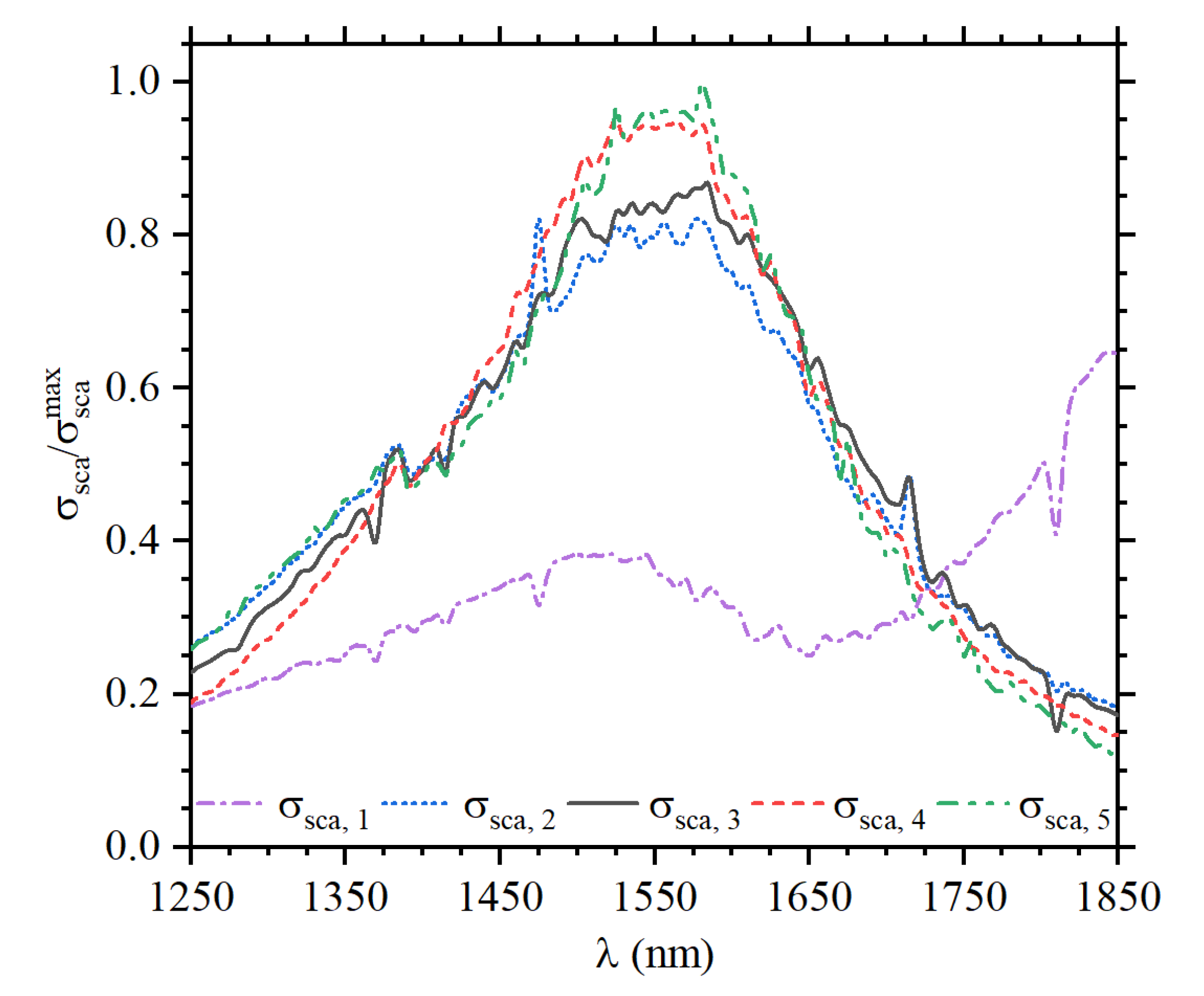
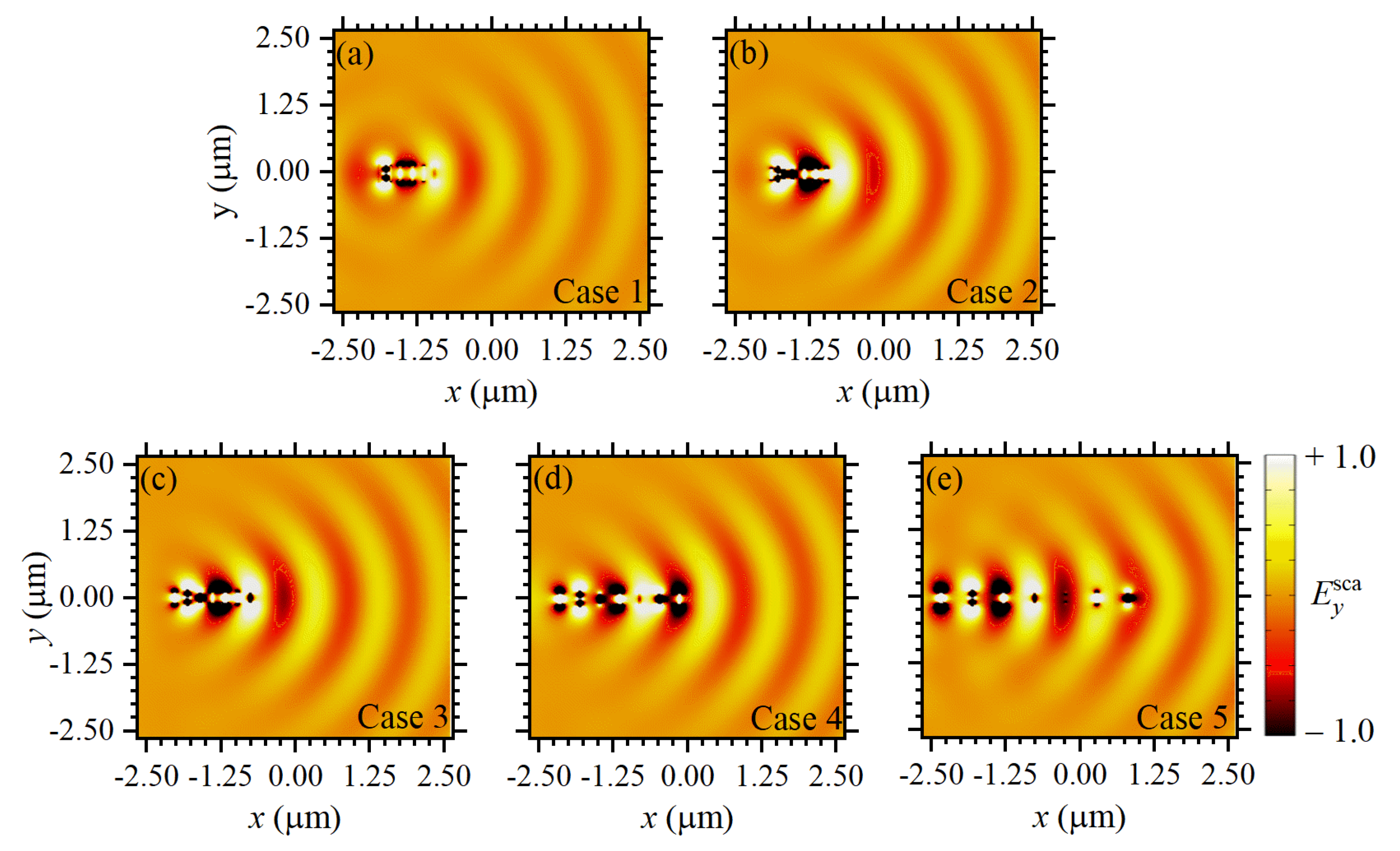
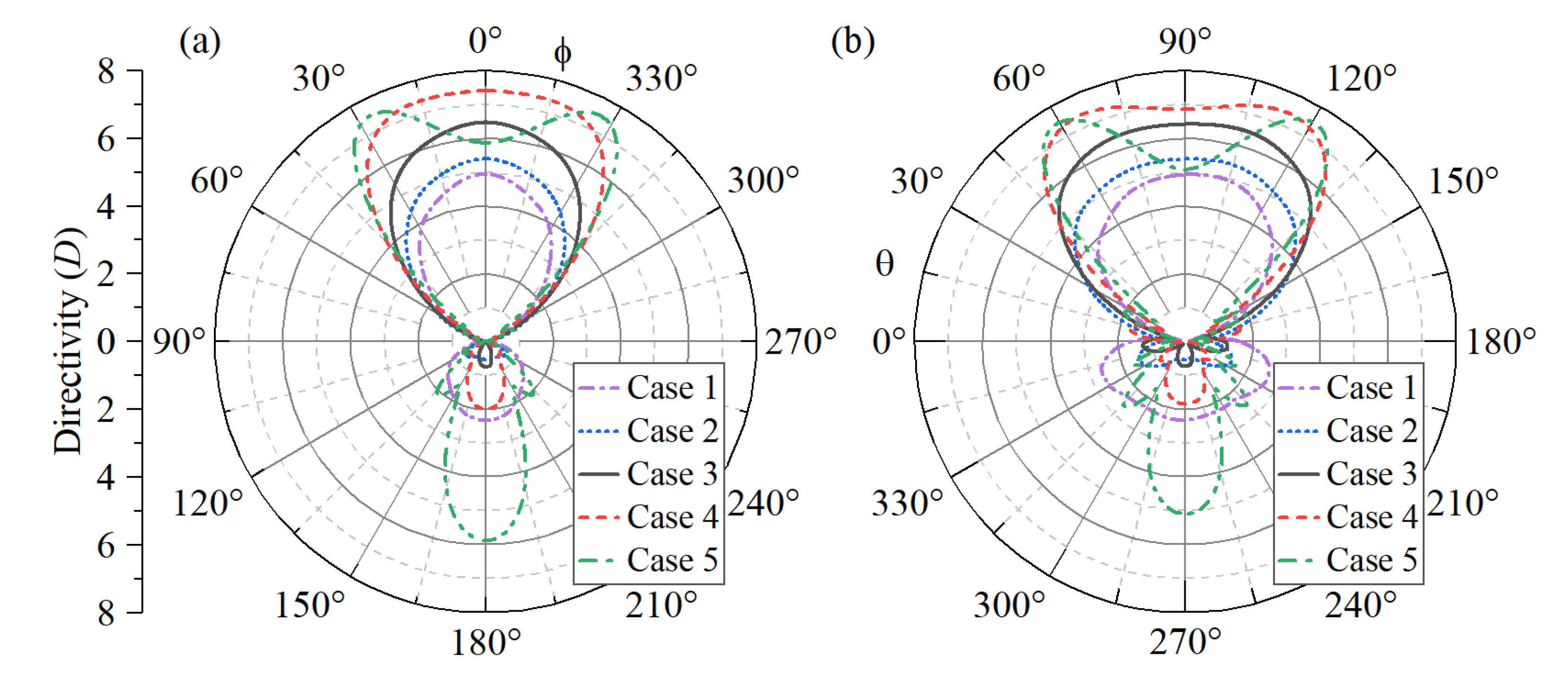
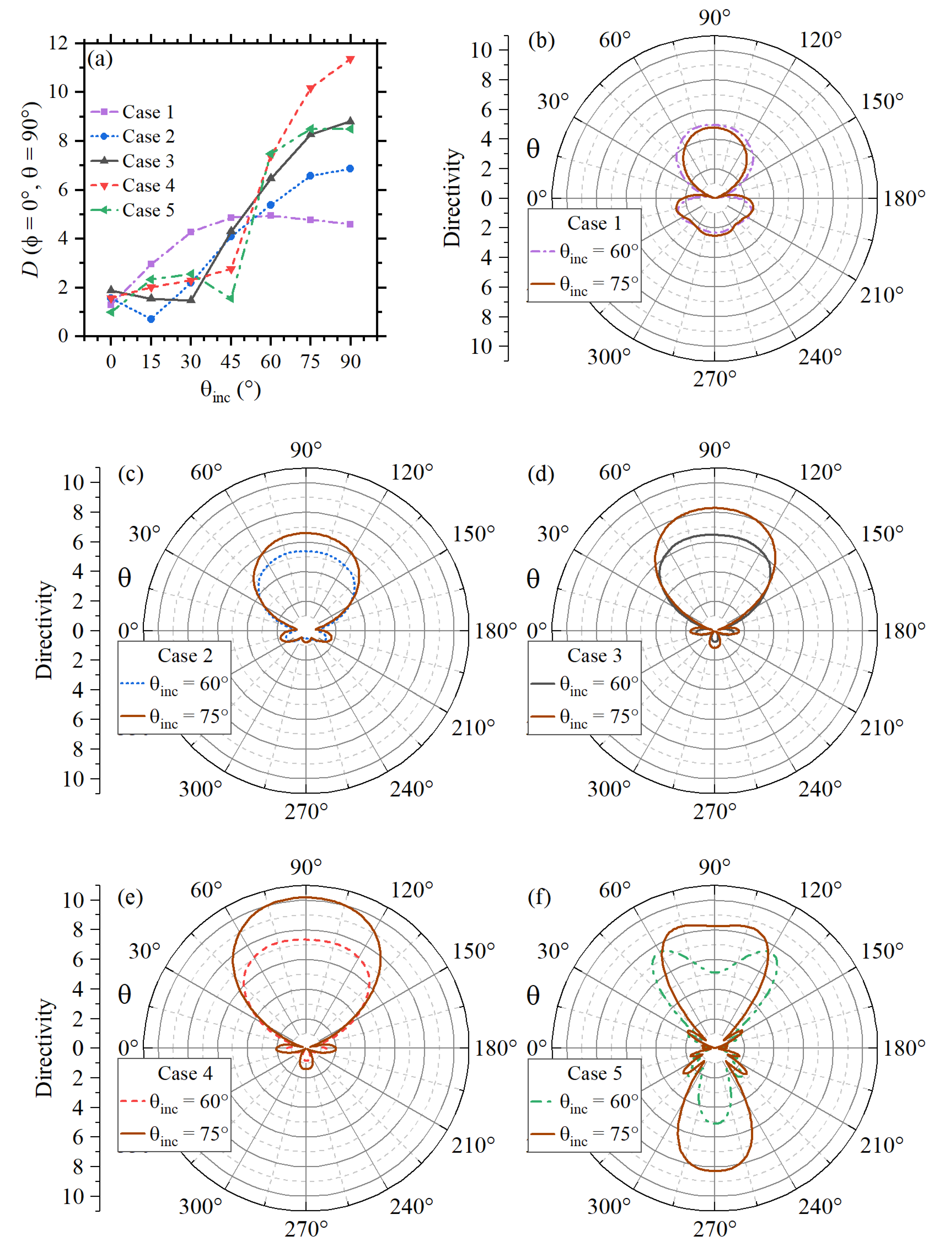
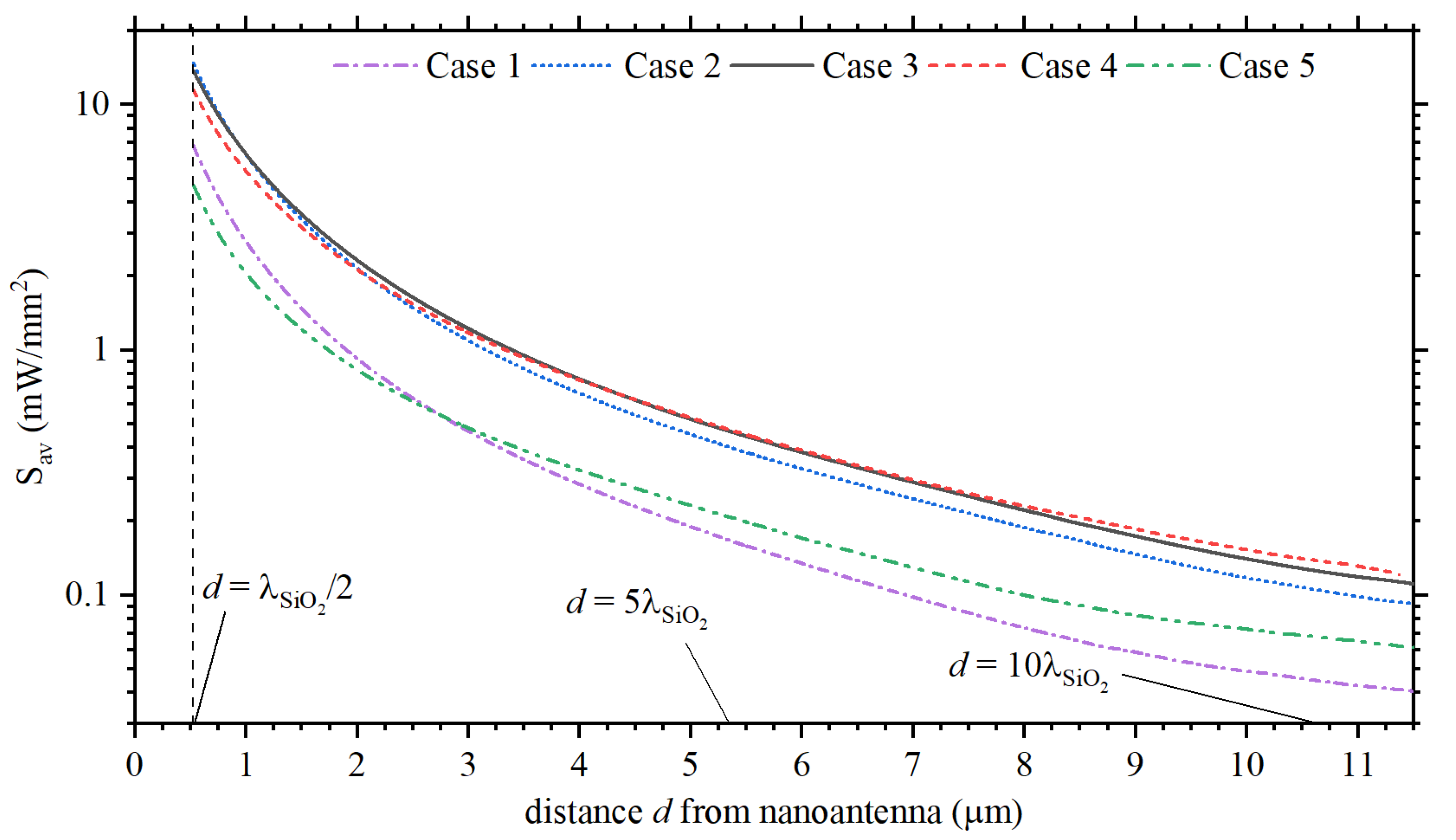


| Lengths (nm) | Case 1 (RF Design Rule Using ) | Case 2 (Optimized Lengths) | Case 3 (Optimized Lengths) | Case 4 (Optimized Lengths) | Case 5 (Optimized Lengths) |
|---|---|---|---|---|---|
| 348 | 194 | 194 | 194 | 194 | |
| 312 | 312 | 312 | 312 | 312 | |
| 277 | 194 | 194 | 194 | 194 | |
| 273 | 194 | 194 | 194 | 194 | |
| 275 | 194 | 194 | 194 | 194 | |
| 277 | 194 | 194 | 194 | 194 | |
| 275 | 194 | 194 | 194 | 194 | |
| Distances (nm) | Case 1 (RF Design Rule Using ) | Case 2 (RF Design Rule Using ) | Case 3 (Distances of ) | Case 4 (Distances of ) | Case 5 (Distances of ) |
| g | 10 | 10 | 10 | 10 | 10 |
| 114 | 114 | 213 | 337 | 529 | |
| 94 | 94 | 213 | 337 | 529 | |
| 147 | 147 | 213 | 337 | 529 | |
| 208 | 208 | 213 | 337 | 529 | |
| 188 | 188 | 213 | 337 | 529 | |
| 188 | 188 | 213 | 337 | 529 |
Publisher’s Note: MDPI stays neutral with regard to jurisdictional claims in published maps and institutional affiliations. |
© 2022 by the authors. Licensee MDPI, Basel, Switzerland. This article is an open access article distributed under the terms and conditions of the Creative Commons Attribution (CC BY) license (https://creativecommons.org/licenses/by/4.0/).
Share and Cite
Damasceno, G.H.B.; Carvalho, W.O.F.; Mejía-Salazar, J.R. Design of Plasmonic Yagi–Uda Nanoantennas for Chip-Scale Optical Wireless Communications. Sensors 2022, 22, 7336. https://doi.org/10.3390/s22197336
Damasceno GHB, Carvalho WOF, Mejía-Salazar JR. Design of Plasmonic Yagi–Uda Nanoantennas for Chip-Scale Optical Wireless Communications. Sensors. 2022; 22(19):7336. https://doi.org/10.3390/s22197336
Chicago/Turabian StyleDamasceno, Gabriel H. B., William O. F. Carvalho, and Jorge Ricardo Mejía-Salazar. 2022. "Design of Plasmonic Yagi–Uda Nanoantennas for Chip-Scale Optical Wireless Communications" Sensors 22, no. 19: 7336. https://doi.org/10.3390/s22197336
APA StyleDamasceno, G. H. B., Carvalho, W. O. F., & Mejía-Salazar, J. R. (2022). Design of Plasmonic Yagi–Uda Nanoantennas for Chip-Scale Optical Wireless Communications. Sensors, 22(19), 7336. https://doi.org/10.3390/s22197336







